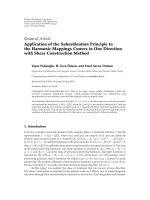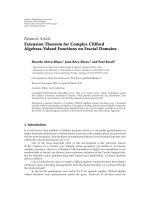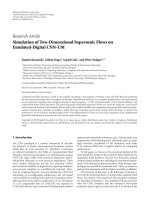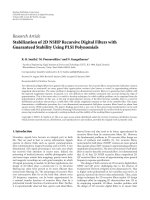Báo cáo hóa học: " Research Article Extension of Oppenheim’s Problem to Bessel Functions" doc
Bạn đang xem bản rút gọn của tài liệu. Xem và tải ngay bản đầy đủ của tài liệu tại đây (479.75 KB, 7 trang )
Hindawi Publishing Corporation
Journal of Inequalities and Applications
Volume 2007, Article ID 82038, 7 pages
doi:10.1155/2007/82038
Research Article
Extension of Oppenheim’s Problem to Bessel Functions
´
Arp
´
ad Baricz and Ling Zhu
Received 10 September 2007; Accepted 22 October 2007
Recommended by Andrea Laforgia
Our aim is to extend some trigonometric inequalities to Bessel functions. Moreover, we
deduce the hyperbolic analogue of these trigonometric inequalities, and we extend these
inequalities to modified Bessel functions.
Copyright © 2007
´
A. Baricz and L. Zhu. This is an open access article distributed under
the Creative Commons Attribution License, which permits unrestricted use, distribution,
and reproduction in any medium, provided the original work is properly cited.
1. Introduction and main results
In 1957, Og ilvy et al. [1](orsee[2, page 238]) asked the following question: for each
a
1
> 0, there is a greatest a
2
and a least a
3
such that for all x ∈ [0,π/2], the inequality
a
2
sin x
1+a
1
cos x
≤ x ≤ a
3
sin x
1+a
1
cos x
(1.1)
holds. Determine a
2
and a
3
as functions of a
1
.
In 1958, Oppenheim and Carver [3](orsee[2, page 238]) gave a part ial solution to
Oppenheim’s problem by showing that, for all a
1
∈ (0,1/2] and x ∈ [0,π/2], (1.1)holds
when a
2
= a
1
+1 and a
3
= π/2. Recently, Zhu [4, Theorem 7] solved, completely, this
problem of Oppenheim, proving that (1.1) holds in the following cases:
(i) if a
1
∈ (0,1/2), then a
2
= a
1
+1anda
3
= π/2;
(ii) if a
1
∈ [1/2,π/2 − 1), then a
2
= 4a
1
(1 − a
2
1
)anda
3
= π/2;
(iii) if a
1
∈ [π/2 − 1,2/π), then a
2
= 4a
1
(1 − a
2
1
)anda
3
= a
1
+1;
(iv) if a
1
≥ 2/π,thena
2
= π/2anda
3
= a
1
+1,
where a
2
and a
3
are the best constants in (i) and (iv), while a
3
is also the best constant in
(ii) and (iii).
Recently, Baricz [5, Theorem 2.20] extended the Carver solution to Bessel functions
(seealso[6] for further results). In this note, our aim is to extend the above-mentioned
2 Journal of Inequalities and Applications
Zhu solution to Bessel functions too. For this, let us consider the function
p
: R→(−∞,
1], defined by
p
(x):= 2
p
Γ(p +1)x
−p
J
p
(x) =
n≥0
(−1/4)
n
(p +1)
n
n!
x
2n
, (1.2)
where
J
p
(x):=
n≥0
(−1)
n
n!·Γ(p +n +1)
x
2
2n+p
∀ x ∈ R (1.3)
is the Bessel function of the first kind [7], and
(p +1)
n
= (p +1)(p +2)···(p + n) = Γ(p +n +1)/Γ(p + 1) (1.4)
is the well-known Pochhammer (or Appell) symbol defined in terms of Euler gamma
function. It is worth mentioning here that, in particular, we have
1/2
(x):=
π/2·x
−1/2
J
1/2
(x) =
sin x
x
,
−1/2
(x):=
π/2·x
1/2
J
−1/2
(x) = cos x.
(1.5)
Now, the extension of Zhu solution reads as follows.
Theorem 1.1. Let p
≥−1/2, |x|≤π/2 and a
1
,a
2
,a
3
such that
(i) if a
1
∈ (0,1/2), then a
2
= a
1
+1and a
3
= π/2;
(ii) if a
1
∈ [1/2,π/2 − 1), then a
2
= 4a
1
(1 − a
2
1
) and a
3
= π/2;
(iii) if a
1
∈ [π/2 − 1,2/π), then a
2
= 4a
1
(1 − a
2
1
) and a
3
= a
1
+1;
(iv) if a
1
≥ 2/π, then a
2
= π/2 and a
3
= a
1
+1.
Then the following inequality holds true:
a
1
(2p +1)+a
2
p+1
(x) ≤ 1+2a
1
(p +1)
p
(x) ≤
a
1
(2p +1)+a
3
p+1
(x), (1.6)
where a
2
and a
3
are the best constants in (i) and (iv), while a
3
is also the best constant in (ii)
and (iii).
We note that, in particular, we have
3/2
(x):= 3
π/2·x
−3/2
J
3/2
(x) = 3
sin x
x
3
−
cos x
x
2
, (1.7)
thus, choosing p
= 1/2inTheorem 1.1, we obtain the following interesting result.
Corollary 1.2. If a
1
,a
2
,a
3
are as in Theorem 1.1,then,forall|x|≤π/2,
3
2a
1
+ a
2
(sin x/x − cos x)
1+3a
1
(sin x/x)
≤ x
2
≤
3
2a
1
+ a
3
(sin x/x − cos x)
1+3a
1
(sin x/x)
. (1.8)
The hyperbolic analogue of (1.1) is the following result.
´
A. Baricz and L. Zhu 3
Theorem 1.3. Let x
≥ 0 and a
1
,a
2
such that
(i) if a
1
≥ 1/2, then a
2
= a
1
+1;
(ii) if a
1
∈ (0,1/2), then a
2
= 4a
1
(1 − a
2
1
).
Then the following inequality holds true:
a
2
sinhx
1+a
1
coshx
≤ x, (1.9)
where a
2
is the best constant in (i). Moreover, when x ≤ 0, the above inequalit y is reversed.
For p>
−1, let us consider the function Ᏽ
p
: R→[1,∞), defined by
Ᏽ
p
(x):= 2
p
Γ(p +1)x
−p
I
p
(x) =
n≥0
(1/4)
n
(p +1)
n
n!
x
2n
, (1.10)
where
I
p
(x):=
n≥0
1
n!·Γ(p +n +1)
x
2
2n+p
∀ x ∈ R (1.11)
is the modified Bessel function of the first kind [7]. On the other hand, it is worth men-
tioning that, in particular, we have
Ᏽ
1/2
(x):=
π/2·x
−1/2
I
1/2
(x) =
sinhx
x
,
Ᏽ
−1/2
(x):=
π/2·x
1/2
I
−1/2
(x) = cosh x,
(1.12)
respectively .
The following inequality for a
1
= 1 was proved recently by Baricz [6, Theorem 4.9],
and provides the extension of Theorem 1.3 to modified Bessel functions.
Theorem 1.4. Let p
≥−1/2, x ∈ R, and a
1
,a
2
be as in Theorem 1.3. Then the following
inequality holds true:
a
1
(2p +1)+a
2
Ᏽ
p+1
(x) ≤ 1+2a
1
(p +1)Ᏽ
p
(x), (1.13)
where a
2
is the best constant in (i).
Finally, observe that, in particular, we have
Ᏽ
3/2
(x):= 3
π/2·x
−3/2
I
3/2
(x) =−3
sinhx
x
3
−
coshx
x
2
, (1.14)
thus, choosing p
= 1/2inTheorem 1.4, we obtain the following interesting result.
Corollary 1.5. If a
1
,a
2
are as in Theorem 1.4,then,forallx ∈ R,
3
2a
1
+ a
2
coshx − sinhx/x
1+3a
1
(sinhx/x)
≤ x
2
. (1.15)
4 Journal of Inequalities and Applications
2.Proofofmainresults
Proof of Theorem 1.1. First, observe that each (1.6) is even, thus we can suppose that x
∈
[0,π/2]. On the other hand, when p =−1/2from(1.5), it follows that (1.6)reducesto
a
2
1/2
(x) ≤ 1+a
1
−1/2
(x) ≤ a
3
1/2
(x), (2.1)
which is equivalent to (1.1), and was proved by Zhu [4, Theorem 7], as we mentioned
above. Recall the well-known Sonine integral formula [7, page 373] for Bessel functions:
J
q+p+1
(x) =
x
p+1
2
p
Γ(p +1)
π/2
0
J
q
(x sin θ) sin
q+1
θ cos
2p+1
θdθ, (2.2)
where p,q>
−1andx ∈ R. From this, we obtain the following formula
q+p+1
(x) =
2
B(p +1,q +1)
π/2
0
q
(x sin θ) sin
2q+1
θ cos
2p+1
θdθ, (2.3)
which will be useful in the sequel. Here, B(p,q)
= Γ(p)Γ(q)/Γ(p + q)isthewell-known
Euler beta function. Changing, in (2.3), p with p
− 1/2, and taking q =−1/2(q = 1/2,
resp.) one has, for all p>
−1/2,x ∈ R,
p
(x) =
2
B(p +1/2,1/2)
π/2
0
−1/2
(x sin θ)cos
2p
θdθ,
p+1
(x) =
2
B(p +1/2,3/2)
π/2
0
1/2
(x sin θ) sin
2
θ cos
2p
θdθ.
(2.4)
Now, changing x with xsin θ in (2.1), multiplying (2.1) with sin
2
θ cos
2p
θ and integrating,
it follows that the expression (using (2.4))
Δ
p
(x):=
π/2
0
sin
2
θ cos
2p
θdθ+ a
1
π/2
0
−1/2
(x sin θ)
1 − cos
2
θ
cos
2p
θdθ
=
1
2
B
p +
1
2
,
3
2
+
a
1
2
B
p +
1
2
,
1
2
p
(x) −
a
1
2
B
p +
3
2
,
1
2
p+1
(x)
(2.5)
satisfies
a
2
2
B
p +
1
2
,
3
2
p+1
(x) ≤ Δ
p
(x) ≤
a
3
2
B
p +
1
2
,
3
2
p+1
(x) . (2.6)
After simplifications, we obtain that (1.6)holds.
Proof of Theorem 1.3. Let us consider the functions f ,g,Q : R→R defined by f (x):= (1 +
a
1
coshx)x, g(x):= sinhx and Q(x):= f (x)/g(x). Clearly, we have
Q(x)
=
f (x)
g(x)
=
f (x) − f (0)
g(x) − g(0)
,
ϕ(x):
=
f
(x)
g
(x)
=
1+a
1
coshx + a
1
x sinh x
coshx
.
(2.7)
´
A. Baricz and L. Zhu 5
Now, in what fol lows, we try to find the minimum values of Q using the monotone
form of l’Hospital’s rule discovered by Anderson et al. [8, Lemma 2.2]. Easy compu-
tations show that ϕ
(x) = u(x)/cosh
2
x,whereu :[0,∞)→R is defined by u(x) = a
1
x +
a
1
(sinhx)(coshx) − sinhx. Moreover, we have u
(x) = (coshx)(2a
1
coshx − 1). For con-
venience, let us consider coshx
= t and define the function v :[1,∞)→R by v(t):= t(2a
1
t − 1).
There are two cases to consider.
Case 1 (a
1
≥ 1/2). Since t ≥ 1 ≥ 1/2a
1
, it follows that u
(x) = v(t) ≥ 0forallx ≥ 0, and,
consequently, the function u is increasing. This implies that u(x)
≥ u(0) = 0, that is,
the function ϕ is increasing on [0,
∞). Using the monotone form of l’Hospital’s rule [8,
Lemma 2.2], we conclude that Q is increasing too on [0,
∞), that is, Q(x) ≥ Q(0) = 1+a
1
for all x ≥ 0. Now, because Q is an even function, clearly, Q is decreasing on (−∞,0], that
is, Q(x)
≥ Q(0) = 1+a
1
for all x ≤ 0.
Case 2 (a
1
∈ (0,1/2)). Because Q is even, it is enough again to consider its restriction to
[0,
∞). However, at this moment, the function Q is not fully monotone on [0,∞). Let α
be the minimum point of the function Q. We can obtain, by direct calculation,
(sinh
2
x)Q
(x) = sinhx + a
1
(sinhx)(coshx) − x cosh x − a
1
x. (2.8)
Since Q
(α) = 0, we have sinhα + a
1
(sinhα)(coshα) − αcosh α − a
1
α = 0, that is,
α
sinhα
=
1+a
1
coshα
a
1
+coshα
. (2.9)
Using this relation, we deduce that
Q(α)
=
1+a
1
coshα
α
sinhα
=
1+a
1
coshα
2
a
1
+coshα
. (2.10)
Finally, because the minimum of the function x
→ (1 + a
1
x)
2
/(a
1
+ x)on[1,∞)is4a
1
(1 −
a
2
1
), we have Q(α) ≥ 4a
1
(1 − a
2
1
), and with this, the proof is complete.
Proof of Theorem 1.4. In analogy to the proof of Theorem 1.1,wecanproveTheorem 1.4
For this, let us recall that, recently, Andr
´
as and Baricz proved [9, Lemma 1] that if x
∈ R
and p>q>−1, then
Ᏽ
p
(x) =
2
B(q +1,p − q)
1
0
Ᏽ
q
(tx)t
2q+1
1 − t
2
p−q−1
dt. (2.11)
Taking, in the above relation, t
= sinθ, we obtain the hyperbolic analogue of (2.3), that
is,
Ᏽ
p
(x) =
2
B(q +1,p − q)
π/2
0
Ᏽ
q
(x sinθ) sin
2q+1
θ cos
2p−2q−1
θdθ. (2.12)
6 Journal of Inequalities and Applications
In particular, taking, in the above relation, q
=−1/2, changing p with p + 1 and taking
q
= 1/2, respectively, we get that, for al l p>−1/2andx ∈ R,
Ᏽ
p
(x) =
2
B(p +1/2,1/2)
π/2
0
Ᏽ
−1/2
(x sin θ)cos
2p
θdθ,
Ᏽ
p+1
(x) =
2
B(p +1/2,3/2)
π/2
0
Ᏽ
1/2
(x sin θ) sin
2
θ cos
2p
θdθ.
(2.13)
Now, using Theorem 1.3, in view of relations (1.12), we deduce that the inequality
a
2
Ᏽ
1/2
(x) ≤ 1+a
1
Ᏽ
−1/2
(x)holdsforallx real number. Thus changing, in this inequality,
x with x sinθ and multiplying both sides with sin
2
θ cos
2p
θ, after integration, we obtain
a
2
2
B
p+
1
2
,
3
2
Ᏽ
p+1
(x) ≤
1
2
B
p+
1
2
,
3
2
+
a
1
2
B
p+
1
2
,
1
2
Ᏽ
p
(x) −
a
1
2
B
p+
3
2
,
1
2
Ᏽ
p+1
(x),
(2.14)
wherewehaveused(2.13). Finally, simplifying this inequality, we obtain the required
inequality.
Remark 2.1. New, researches, which are concerned with Oppenheim’s problem, are in
active progress, readers can refer to [4, 10–13].
Acknowledgment
The first author research is partially supported by the Institute of Mathematics, University
of Debrecen, Hungary.
References
[1] C. S. Ogilvy, A. Oppenheim, V. F. Ivanoff, L. F. Ford Jr., D. R. Fulkerson, and V. K. Narayanan
Jr., “Elementary problems and solutions: problems for solution: E1275-E1280,” The American
Mathematical Monthly, vol. 64, no. 7, pp. 504–505, 1957.
[2] D. S. Mitrinovi
´
c, Analytic inequalities, vol. 1965 of Die Grundlehren der Mathematischen Wisen-
schaften, Springer, New York, NY, USA, 1970.
[3] A. Oppenheim and W. B. Carver, “Elementary problems and solutions: solutions: E1277,” The
American Mathematical Monthly, vol. 65, no. 3, pp. 206–209, 1958.
[4] L. Zhu, “A solution of a problem of oppeheim,” Mathemat ical Inequalities & Applications, vol. 10,
no. 1, pp. 57–61, 2007.
[5]
´
A. Baricz, “Functional inequalities involving Bessel and modified Bessel functions of the first
kind,” to appear in Expositiones Mathematicae.
[6]
´
A. Baricz, “Some inequalities involving generalized Bessel functions,” Mathematical Inequalities
&Applications, vol. 10, no. 4, pp. 827–842, 2007.
[7] G. N. Watson, A treatise on the Theory of Bessel Functions, Cambridge University Press, Cam-
bridge, UK, 1962.
[8] G. D. Anderson, M. K. Vamanamurthy, and M. Vuorinen, “Inequalities for quasiconformal map-
pings in space,” Pacific Journal of Mathematics, vol. 160, no. 1, pp. 1–18, 1993.
[9] Sz. Andr
´
as and
´
A. Baricz, “Monotonicity property of generalized and normalized Bessel func-
tions of complex order,” submitted to Journal of Inequalities in Pure and Applied Mathematics.
[10] L. Zhu, “On shafer-fink inequalities,” Mathematical Inequalities & Applications,vol.8,no.4,
pp. 571–574, 2005.
´
A. Baricz and L. Zhu 7
[11] L. Zhu, “On Shafer-Fink-type inequality,” Journal of Inequalities and Applications, vol. 2007,
Article ID 67430, 4 pages, 2007.
[12] B. J. Male
ˇ
sevi
´
c, “One method for proving inequalities by computer,” Journal of Inequalities and
Applications, vol. 2007, Article ID 78691, 8 pages, 2007.
[13] B. J. Male
ˇ
sevi
´
c,“Anapplicationofλ-method on inequalities of Shafer-Fink’s type,” Mathematical
Inequalities & Applications, vol. 10, no. 3, pp. 529–534, 2007.
´
Arp
´
ad Baricz: Faculty of Economics, Babes¸-Bolyai University, RO-400591 Cluj-Napoca, Romania
Email address:
Ling Zhu: Department of Mathematics, Zhejiang Gongshang University, Hangzhou 310018, China
Email address:









